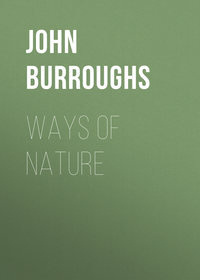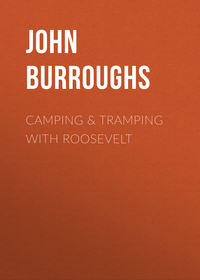 полная версия
полная версияBird Stories from Burroughs
THE BALTIMORE ORIOLE
The nest of nests, the ideal nest, is unquestionably that of the Baltimore oriole. It is the only perfectly pensile nest we have. The nest of the orchard oriole is indeed mainly so, but this bird generally builds lower and shallower, more after the manner of the vireos.
The Baltimore oriole loves to attach its nest to the swaying branches of the tallest elms, making no attempt at concealment, but satisfied if the position be high and the branch pendent. This nest would seem to cost more time and skill than any other bird structure. A peculiar flax-like material seems to be always sought after and always found. The nest when completed assumes the form of a large, suspended gourd. The walls are thin but firm, and proof against the most driving rain. The mouth is hemmed or over-handed with strings or horsehair, and the sides are usually sewed through and through with the same.
Not particular as to the matter of secrecy, the bird is not particular as to material, so that it be of the nature of strings or threads. A lady friend once told me that, while she was working by an open window, one of these birds approached while her back was turned, and, seizing a skein of some kind of thread or yarn, made off with it to its half-finished nest. But the perverse yarn caught fast in the branches, and, in the bird's efforts to extricate it, got hopelessly tangled. She tugged away at it all day, but was finally obliged to content herself with a few detached portions. The fluttering strings were an eyesore to her ever after, and, passing and repassing, she would give them a spiteful jerk, as much as to say, "There is that confounded yarn that gave me so much trouble."
One day in Kentucky I saw an oriole weave into her nest unusual material. As we sat upon the lawn in front of the cottage, we had noticed the bird just beginning her structure, suspending it from a long, low branch of the Kentucky coffee-tree that grew but a few feet away. I suggested to my host that if he would take some brilliant yarn and scatter it about upon the shrubbery, the fence, and the walks, the bird would probably avail herself of it, and weave a novel nest. I had heard of its being done, but had never tried it myself. The suggestion was at once acted upon, and in a few moments a handful of zephyr yarn, crimson, orange, green, yellow, and blue, was distributed about the grounds. As we sat at dinner a few moments later, I saw the eager bird flying up toward her nest with one of these brilliant yarns streaming behind her. They had caught her eye at once, and she fell to work upon them with a will; not a bit daunted by their brilliant color, she soon had a crimson spot there amid the green leaves. She afforded us rare amusement all the afternoon and the next morning. How she seemed to congratulate herself over her rare find! How vigorously she knotted those strings to her branch and gathered the ends in and sewed them through and through the structure, jerking them spitefully like a housewife burdened with many cares! How savagely she would fly at her neighbor, an oriole that had a nest just over the fence a few yards away, when she invaded her territory! The male looked on approvingly, but did not offer to lend a hand. There is something in the manner of the female on such occasions, something so decisive and emphatic, that one entirely approves of the course of the male in not meddling or offering any suggestions. It is the wife's enterprise, and she evidently knows her own mind so well that the husband keeps aloof, or plays the part of an approving spectator.
The woolen yarn was ill-suited to the Kentucky climate. This fact the bird seemed to appreciate, for she used it only in the upper part of her nest, in attaching it to the branch and in binding and compacting the rim, making the sides and bottom of hemp, leaving it thin and airy, much more so than are the same nests with us. No other bird would, perhaps, have used such brilliant material; their instincts of concealment would have revolted, but the oriole aims more to make its nest inaccessible than to hide it. Its position and depth insure its safety.
THE WHIP-POOR-WILL
One day in May, walking in the woods, I came upon the nest of a whip-poor-will, or rather its eggs, for it builds no nest, – two elliptical whitish spotted eggs lying upon the dry leaves. My foot was within a yard of the mother bird before she flew. I wondered what a sharp eye would detect curious or characteristic in the ways of the bird, so I came to the place many times and had a look. It was always a task to separate the bird from her surroundings, though I stood within a few feet of her, and knew exactly where to look. One had to bear on with his eye, as it were, and refuse to be baffled. The sticks and leaves, and bits of black or dark-brown bark, were all exactly copied in the bird's plumage. And then she did sit so close, and simulate so well a shapeless, decaying piece of wood or bark! Twice I brought a companion, and, guiding his eye to the spot, noted how difficult it was for him to make out there, in full view upon the dry leaves, any semblance to a bird. When the bird returned after being disturbed, she would alight within a few inches of her eggs, and then, after a moment's pause, hobble awkwardly upon them.
After the young had appeared, all the wit of the bird came into play. I was on hand the next day, I think. The mother bird sprang up when I was within a pace of her, and in doing so fanned the leaves with her wings till they sprang up, too; as the leaves started the young started, and as they were of the same color, to tell which was the leaf and which the bird was a trying task to any eye. I came the next day, when the same tactics were repeated. Once a leaf fell upon one of the young birds and nearly hid it. The young are covered with a reddish down, like a young partridge, and soon follow their mother about. When disturbed, they gave but one leap, then settled down, perfectly motionless and stupid, with eyes closed. The parent bird, on these occasions, made frantic efforts to decoy me away from her young. She would fly a few paces and fall upon her breast, and a spasm, like that of death, would run through her tremulous outstretched wings and prostrate body. She kept a sharp eye out the mean while to see if the ruse took, and, if it did not, she was quickly cured, and, moving about to some other point, tried to draw my attention as before. When followed she always alighted upon the ground, dropping down in a sudden, peculiar way. The second or third day both old and young had disappeared.
The whip-poor-will walks as awkwardly as a swallow, which is as awkward as a man in a bag, and yet she manages to lead her young about the woods. The latter, I think, move by leaps and sudden spurts, their protective coloring shielding them most effectively.
As the shadows deepen and the stars begin to come out, the whip-poor-will suddenly strikes up. What a rude intrusion upon the serenity and harmony of the hour! A cry without music, insistent, reiterated, loud, penetrating, and yet the ear welcomes it; the night and the solitude are so vast that they can stand it; and when, an hour later, as the night enters into full possession, the bird comes and serenades me under my window or upon my doorstep, my heart warms toward it. Its cry is a love-call, and there is something of the ardor and persistence of love in it, and when the female responds, and comes and hovers near, there is an interchange of subdued, caressing tones between the two birds that it is a delight to hear. During my first summer in my cabin one bird used to strike up every night from a high ledge of rocks in front of my door. At just such a moment in the twilight he would begin, the first to break the stillness. Then the others would follow, till the solitude was vocal with their calls. They are rarely heard later than ten o'clock. Then at daybreak they take up the tale again, whipping poor Will till one pities him. One April morning between three and four o'clock, hearing one strike up near my window, I began counting its calls. My neighbor had told me he had heard one call over two hundred times without a break, which seemed to me a big story. But I have a much bigger one to tell. This bird actually laid upon the back of poor Will one thousand and eighty-eight blows, with only a barely perceptible pause here and there, as if to catch its breath. Then it stopped about half a minute and began again, uttering this time three hundred and ninety calls, when it paused, flew a little farther away, took up the tale once more, and continued till I fell asleep.
By day the whip-poor-will apparently sits motionless upon the ground. A few times in my walks through the woods I have started one up from almost under my feet. On such occasions the bird's movements suggest those of a bat; its wings make no noise, and it wavers about in an uncertain manner, and quickly drops to the ground again. One June day we flushed an old one with her two young, but there was no indecision or hesitation in the manner of the mother bird this time. The young were more than half fledged, and they scampered away a few yards and suddenly squatted upon the ground, where their assimilative coloring rendered them almost invisible. Then the anxious parent put forth all her arts to absorb our attention and lure us away from her offspring. She flitted before us from side to side, with spread wings and tail, now falling upon the ground, where she would remain a moment as if quite disabled, then perching upon an old stump or low branch with drooping, quivering wings, and imploring us by every gesture to take her and spare her young. My companion had his camera with him, but the bird would not remain long enough in one position for him to get her picture.
THE BLACK-THROATED BLUE WARBLER A SEARCH FOR A RARE NEST
I had set out in hopes of finding a rare nest, – the nest of the black-throated blue-backed warbler, which, it seemed, with one or two others, was still wanting to make the history of our warblers complete. The woods were extensive, and full of deep, dark tangles, and looking for any particular nest seemed about as hopeless a task as searching for a needle in a haystack, as the old saying is. Where to begin, and how? But the principle is the same as in looking for a hen's nest, – first find your bird, then watch its movements.
The bird is in these woods, for I have seen him scores of times, but whether he builds high or low, on the ground or in the trees, is all unknown to me. That is his song now, – "twe-twea-twe-e-e-a," with a peculiar summer languor and plaintiveness, and issuing from the lower branches and growths. Presently we – for I have been joined by a companion – discover the bird, a male, insecting in the top of a newly fallen hemlock. The black, white, and blue of his uniform are seen at a glance. His movements are quite slow compared with some of the warblers. If he will only betray the locality of that little domicile where his plainly clad mate is evidently sitting, it is all we will ask of him. But this he seems in no wise disposed to do. Here and there, and up and down, we follow him, often losing him, and as often refinding him by his song; but the clew to his nest, how shall we get it? Does he never go home to see how things are getting on, or to see if his presence is not needed, or to take madam a morsel of food? No doubt he keeps within earshot, and a cry of distress or alarm from the mother bird would bring him to the spot in an instant. Would that some evil fate would make her cry, then! Presently he encounters a rival. His feeding-ground infringes upon that of another, and the two birds regard each other threateningly. This is a good sign, for their nests are evidently near.
Their battle-cry is a low, peculiar chirp, not very fierce, but bantering and confident. They quickly come to blows, but it is a very fantastic battle, and, as it would seem, indulged in more to satisfy their sense of honor than to hurt each other, for neither party gets the better of the other, and they separate a few paces and sing, and squeak, and challenge each other in a very happy frame of mind. The gauntlet is no sooner thrown down than it is again taken up by one or the other, and in the course of fifteen or twenty minutes they have three or four encounters, separating a little, then provoked to return again like two cocks, till finally they withdraw beyond hearing of each other, – both, no doubt, claiming the victory. But the secret of the nest is still kept. Once I think I have it. I catch a glimpse of a bird which looks like the female, and near by, in a small hemlock about eight feet from the ground, my eye detects a nest. But as I come up under it, I can see daylight through it, and that it is empty, – evidently only partly finished, not lined or padded yet. Now if the bird will only return and claim it, the point will be gained. But we wait and watch in vain. The architect has knocked off to-day, and we must come again, or continue our search.
Despairing of finding either of the nests of the two males, we pushed on through the woods to try our luck elsewhere. Before long, just as we were about to plunge down a hill into a dense, swampy part of the woods, we discovered a pair of the birds we were in quest of. They had food in their beaks, and, as we paused, showed great signs of alarm, indicating that the nest was in the immediate vicinity. This was enough. We would pause here and find this nest, anyhow. To make a sure thing of it, we determined to watch the parent birds till we had wrung from them their secret. So we doggedly crouched down and watched them, and they watched us. It was diamond cut diamond. But as we felt constrained in our movements, desiring, if possible, to keep so quiet that the birds would, after a while, see in us only two harmless stumps or prostrate logs, we had much the worst of it. The mosquitoes were quite taken with our quiet, and knew us from logs and stumps in a moment. Neither were the birds deceived, not even when we tried the Indian's tactics, and plumed ourselves with green branches. Ah, the suspicious creatures, how they watched us with the food in their beaks, abstaining for one whole hour from ministering to that precious charge which otherwise would have been visited every few moments! Quite near us they would come at times, between us and the nest, eying us so sharply. Then they would move off, and apparently try to forget our presence. Was it to deceive us, or to persuade himself and his mate that there was no serious cause for alarm, that the male would now and then strike up in full song and move off to some distance through the trees? But the mother bird did not allow herself to lose sight of us at all, and both birds, after carrying the food in their beaks a long time, would swallow it themselves. Then they would obtain another morsel and apparently approach very near the nest, when their caution or prudence would come to their aid, and they would swallow the food and hasten away. I thought the young birds would cry out, but not a syllable from them. Yet this was, no doubt, what kept the parent birds away from the nest. The clamor the young would have set up on the approach of the old with food would have exposed everything.
After a time I felt sure I knew within a few feet where the nest was concealed. Indeed, I thought I knew the identical bush. Then the birds approached each other again and grew very confidential about another locality some rods below. This puzzled us, and, seeing the whole afternoon might be spent in this manner and the mystery unsolved, we determined to change our tactics and institute a thorough search of the locality. This procedure soon brought things to a crisis, for, as my companion clambered over a log by a little hemlock, a few yards from where we had been sitting, with a cry of alarm out sprang the young birds from their nest in the hemlock, and, scampering and fluttering over the leaves, disappeared in different directions. Instantly the parent birds were on the scene in an agony of alarm. Their distress was pitiful. They threw themselves on the ground at our very feet, and fluttered, and cried, and trailed themselves before us, to draw us away from the place, or distract our attention from the helpless young. I shall not forget the male bird, how bright he looked, how sharp the contrast as he trailed his painted plumage there on the dry leaves. Apparently he was seriously disabled. He would start up as if exerting every muscle to fly away, but no use; down he would come, with a helpless, fluttering motion, before he had gone two yards, and apparently you had only to go and pick him up. But before you could pick him up, he had recovered somewhat and flown a little farther; and thus, if you were tempted to follow him, you would soon find yourself some distance from the scene of the nest, and both old and young well out of your reach. The female bird was not less solicitous, and practiced the same arts upon us to decoy us away, but her dull plumage rendered her less noticeable. The male was clad in holiday attire, but his mate in an every-day working-garb.
The nest was built in the fork of a little hemlock, about fifteen inches from the ground, and was a thick, firm structure, composed of the finer material of the woods, with a lining of very delicate roots or rootlets. There were four young birds and one addled egg.
THE MARSH HAWK A MARSH HAWK'S NEST, A YOUNG HAWK, AND A VISIT TO A QUAIL ON HER NEST
Most country boys, I fancy, know the marsh hawk. It is he you see flying low over the fields, beating about bushes and marshes and dipping over the fences, with his attention directed to the ground beneath him. He is a cat on wings. He keeps so low that the birds and mice do not see him till he is fairly upon them. The hen-hawk swoops down upon the meadow-mouse from his position high in air, or from the top of a dead tree; but the marsh hawk stalks him and comes suddenly upon him from over the fence, or from behind a low bush or tuft of grass. He is nearly as large as the hen-hawk, but has a much longer tail. When I was a boy I used to call him the long-tailed hawk. The male is of a bluish slate-color; the female reddish-brown, like the hen-hawk, with a white rump.
Unlike the other hawks, they nest on the ground in low, thick marshy places. For several seasons a pair have nested in a bushy marsh a few miles back of me, near the house of a farmer friend of mine, who has a keen eye for the wild life about him. Two years ago he found the nest, but when I got over to see it the next week, it had been robbed, probably by some boys in the neighborhood. The past season, in April or May, by watching the mother bird, he found the nest again. It was in a marshy place, several acres in extent, in the bottom of a valley, and thickly grown with hardback, prickly ash, smilax, and other low thorny bushes. My friend took me to the brink of a low hill, and pointed out to me in the marsh below us, as nearly as he could, just where the nest was located. Then we crossed the pasture, entered upon the marsh, and made our way cautiously toward it. The wild, thorny growths, waist-high, had to be carefully dealt with. As we neared the spot, I used my eyes the best I could, but I did not see the hawk till she sprang into the air not ten yards away from us. She went screaming upward, and was soon sailing in a circle far above us. There, on a coarse matting of twigs and weeds, lay five snow-white eggs, a little more than half as large as hens' eggs. My companion said the male hawk would probably soon appear and join the female, but he did not. She kept drifting away to the east, and was soon gone from our sight.
We presently withdrew and secreted ourselves behind the stone wall, in hopes of seeing the mother hawk return. She appeared in the distance, but seemed to know she was being watched, and kept away.
About ten days later we made another visit to the nest. An adventurous young Chicago lady also wanted to see a hawk's nest, and so accompanied us. This time three of the eggs were hatched, and as the mother hawk sprang up, either by accident or intentionally she threw two of the young hawks some feet from the nest. She rose up and screamed angrily. Then, turning toward us, she came like an arrow straight at the young lady, a bright plume in whose hat probably drew her fire. The damsel gathered up her skirts about her and beat a hasty retreat. Hawks were not so pretty as she thought they were. A large hawk launched at one's face from high in the air is calculated to make one a little nervous. It is such a fearful incline down which the bird comes, and she is aiming exactly toward your eye. When within about thirty feet of you, she turns upward with a rushing sound, and, mounting higher, falls toward you again. She is only firing blank cartridges, as it were; but it usually has the desired effect, and beats the enemy off.
After we had inspected the young hawks, a neighbor of my friend offered to conduct us to a quail's nest. Anything in the shape of a nest is always welcome, it is such a mystery, such a centre of interest and affection, and, if upon the ground, is usually something so dainty and exquisite amid the natural wreckage and confusion. A ground nest seems so exposed, too, that it always gives a little thrill of pleasurable surprise to see the group of frail eggs resting there behind so slight a barrier. I will walk a long distance any day just to see a song sparrow's nest amid the stubble or under a tuft of grass. It is a jewel in a rosette of jewels, with a frill of weeds or turf. A quail's nest I had never seen, and to be shown one within the hunting-ground of this murderous hawk would be a double pleasure. Such a quiet, secluded, grass-grown highway as we moved along was itself a rare treat. Sequestered was the word that the little valley suggested, and peace the feeling the road evoked. The farmer, whose fields lay about us, half grown with weeds and bushes, evidently did not make stir or noise enough to disturb anything. Beside this rustic highway, bounded by old mossy stone walls, and within a stone's throw of the farmer's barn, the quail had made her nest. It was just under the edge of a prostrate thorn-bush.
"The nest is right there," said the farmer, pausing within ten feet of it, and pointing to the spot with his stick.
In a moment or two we could make out the mottled brown plumage of the sitting bird. Then we approached her cautiously till we bent above her.
She never moved a feather.
Then I put my cane down in the brush behind her. We wanted to see the eggs, yet did not want rudely to disturb the sitting hen.
She would not move.
Then I put down my hand within a few inches of her; still she kept her place. Should we have to lift her off bodily?
Then the young lady put down her hand, probably the prettiest and the whitest hand the quail had ever seen. At least it started her, and off she sprang, uncovering such a crowded nest of eggs as I had never before beheld. Twenty-one of them! a ring or disk of white like a china tea-saucer. You could not help saying, How pretty! How cunning! like baby hens' eggs, as if the bird were playing at sitting, as children play at housekeeping.
If I had known how crowded her nest was, I should not have dared disturb her, for fear she would break some of them. But not an egg suffered harm by her sudden flight. And no harm came to the nest afterward. Every egg hatched, I was told, and the little chicks, hardly bigger than bumblebees, were led away by the mother into the fields.
In about a week I paid another visit to the hawk's nest. The eggs were all hatched, and the mother bird was hovering near. I shall never forget the curious expression of those young hawks sitting there on the ground. The expression was not one of youth, but of extreme age. Such an ancient, infirm look as they had, – the sharp, dark, and shrunken look about the face and eyes, and their feeble, tottering motions! They sat upon their elbows and the hind part of their bodies, and their pale, withered legs and feet extended before them in the most helpless fashion. Their angular bodies were covered with a pale yellowish down, like that of a chicken; their heads had a plucked, seedy appearance; and their long, strong, naked wings hung down by their sides till they touched the ground: power and ferocity in the first rude draught, shorn of everything but its sinister ugliness. Another curious thing was the gradation of the young in size; they tapered down regularly from the first to the fifth, as if there had been, as probably there was, an interval of a day or two between the hatchings.









